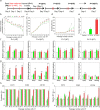Mild heat treatment in vitro potentiates human adipose stem cells: delayed aging and improved quality for long term culture
- PMID: 38008757
- PMCID: PMC10680349
- DOI: 10.1186/s40824-023-00448-w
Mild heat treatment in vitro potentiates human adipose stem cells: delayed aging and improved quality for long term culture
Abstract
Background: Mesenchymal stem cells (MSCs) have gained significant attention for diverse biomedical applications, including cell-based therapy. Hence, in vitro expansion of MSCs is critical; however, in vitro MSC culture, especially long-term culture, inevitably leads to significant loss of stemness, growth, and differentiation potential.
Method: Effects of mild heat treatment (HT) conditions (temperature, duration, and repetition) on the characteristics of adipose tissue-derived MSCs in vitro were systematically investigated. Characteristics of the MSCs subjected to the predetermined HT conditions (41 or 44ºC, 1 h, and 2X HT) were first analyzed in a single passage using various assays. In addition, the feasibility of HT for long-term MSC culture was studied. The RNA sequencing analyses were performed to elucidate the mechanism of HT effects on MSCs.
Results: A comprehensive exploration of various HT conditions revealed that specific mild HT at 41ºC or 44ºC for 1 h upregulated the expression of heat shock proteins and stemness markers and enhanced differentiation potentials. Furthermore, periodic mild HT extended the maintenance of growth rate and stemness of MSCs up to an additional 10 passages, which substantially retarded their spontaneous aging during subsequent in vitro culture. RNA sequencing analyses unveiled that HT downregulated genes associated with aging and apoptosis.
Conclusion: Our study successfully demonstrated that mild HT of MSCs has positive effects on their application in various biomedical fields, enhancing their capabilities and slowing down the aging process.
Keywords: Aging; Heat treatment; In vitro culture; Mesenchymal stem cell; Stemness.
© 2023. The Author(s).
Conflict of interest statement
The authors declare that they have no known competing financial interests that could have appeared to influence the work reported in this paper.
Figures








Similar articles
-
Downregulation of Melanoma Cell Adhesion Molecule (MCAM/CD146) Accelerates Cellular Senescence in Human Umbilical Cord Blood-Derived Mesenchymal Stem Cells.Stem Cells Transl Med. 2016 Apr;5(4):427-39. doi: 10.5966/sctm.2015-0109. Epub 2016 Mar 3. Stem Cells Transl Med. 2016. PMID: 26941359 Free PMC article.
-
Changes in phenotype and differentiation potential of human mesenchymal stem cells aging in vitro.Stem Cell Res Ther. 2018 May 11;9(1):131. doi: 10.1186/s13287-018-0876-3. Stem Cell Res Ther. 2018. PMID: 29751774 Free PMC article.
-
In vitro aging alters the gene expression and secretome composition of canine adipose-derived mesenchymal stem cells.Front Vet Sci. 2024 Mar 28;11:1387174. doi: 10.3389/fvets.2024.1387174. eCollection 2024. Front Vet Sci. 2024. PMID: 38605926 Free PMC article.
-
Native and solubilized decellularized extracellular matrix: A critical assessment of their potential for improving the expansion of mesenchymal stem cells.Acta Biomater. 2017 Jun;55:1-12. doi: 10.1016/j.actbio.2017.04.014. Epub 2017 Apr 12. Acta Biomater. 2017. PMID: 28412553 Review.
-
In vitro Culture of Naïve Human Bone Marrow Mesenchymal Stem Cells: A Stemness Based Approach.Front Cell Dev Biol. 2017 Aug 23;5:69. doi: 10.3389/fcell.2017.00069. eCollection 2017. Front Cell Dev Biol. 2017. PMID: 28884113 Free PMC article. Review.
Cited by
-
A Multifunctional Nanocatalytic Metal-Organic Framework as a Ferroptosis Amplifier for Mild Hyperthermia Photothermal Therapy.Research (Wash D C). 2024 Jul 1;7:0397. doi: 10.34133/research.0397. eCollection 2024. Research (Wash D C). 2024. PMID: 38952997 Free PMC article.
-
Enhanced Chondrogenic Differentiation of Electrically Primed Human Mesenchymal Stem Cells for the Regeneration of Osteochondral Defects.Biomater Res. 2024 Dec 18;28:0109. doi: 10.34133/bmr.0109. eCollection 2024. Biomater Res. 2024. PMID: 39697183 Free PMC article.
References
Grants and funding
LinkOut - more resources
Full Text Sources

